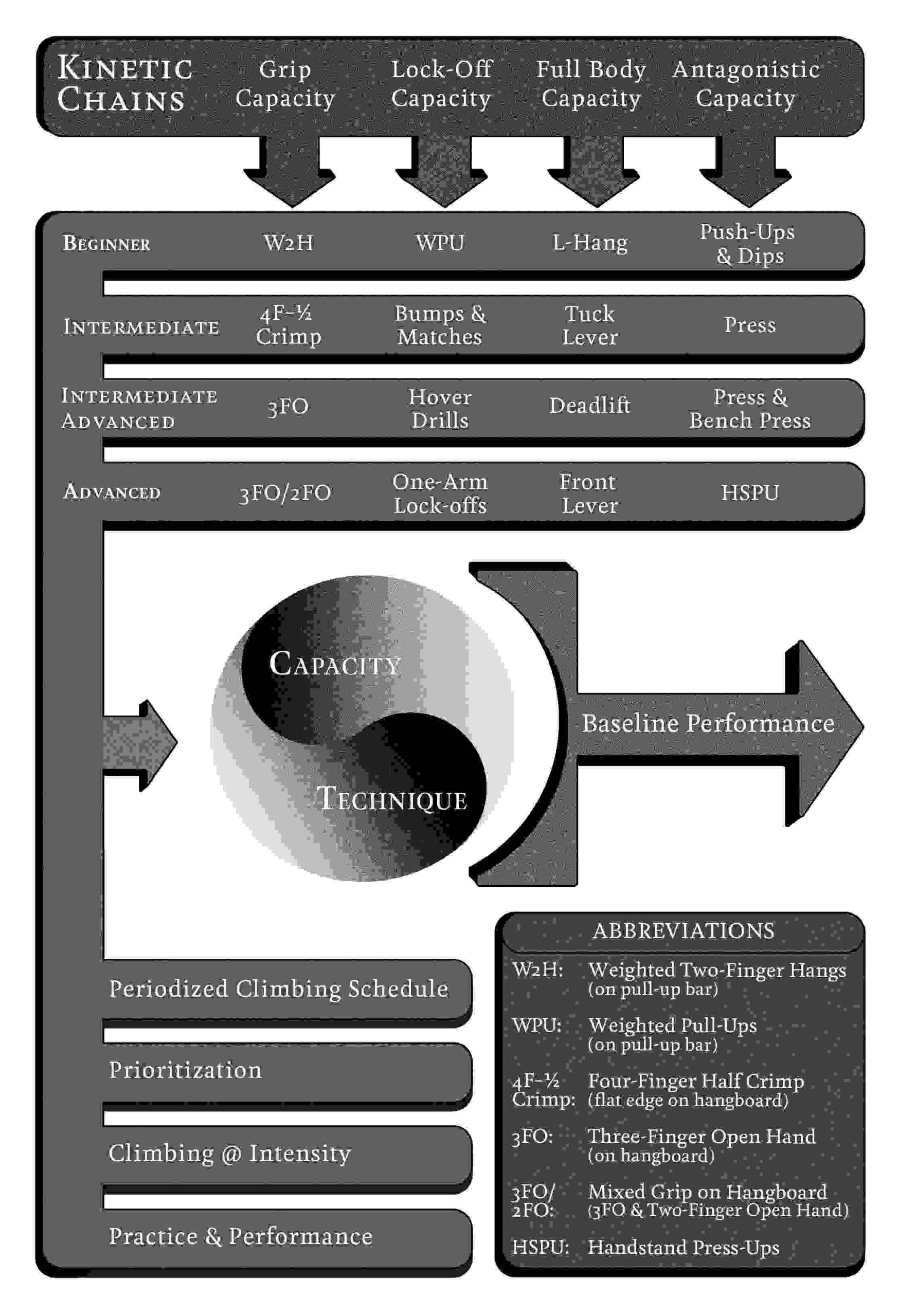
Distinguishing training movements as being beginner, intermediate, or advanced is made to illustrate how training movements change throughout the years. This forms a progression, and its order is less important than avoiding training monotony. For example, if you’re new to training, it’s possible to increase full body capacity (core strength) using weight training. Or, as the graphic alludes, weight training could be the steppingstone to performing an advanced gymnastic movement like the front lever. Equally, either method may provide a remedy to the monotonous, structural wear and tear of the other as an advanced trainee.
Grip, lock-off, and full body training directly relate to climbing performance, while antagonistic training just makes good sense. One movement per category is sufficient. Even reducing the total number of training movements to two is preferred if that’s the difference between being sporadic or remaining consistent. Scheduling more than four movements or working out more than twice a week could dimmish both training progress and technical proficiency. Yet each trainee’s tolerance is unique.
A period of regular exposure to a movement pattern is necessary to obtain the desired outcome. So, programming any supplemental movement should be done in a way that supports a high level of climbing performance. Brief workouts with good transference are of greater long-term benefit than long, exhaustive workouts (i.e., hangboard workout vs. road biking or doing laps on easy terrain). The “less is more” strategy is especially beneficial when amortized over time because the process is what cultivates training gains, not any one workout.
During the training season the primary objective is to improve climbing performance. Emphasizing movement-quality at a high percentage of your total technical and physical capacity is recommended. This limits unproductive volume and expands technical proficiency. It also integrates training gains into your bouldering or route climbing performance.
Supplemental training emphasizes an increase to physical capacity, but there are also certain climbing-only strategies that can accomplish the goal of building strength, power, and endurance.
Training walls like the Moon, Kilter, or Tension boards emphasize strength and power for bouldering the same way that bouldering emphasizes strength and power for route climbing. These are both examples of prioritizing a physical capacity to increase the performance of your primary objective. At a meaningful intensity, the reduced number of climbing movements require more strength and power to be performed more precisely. In turn, with enough regular exposure technical skills expand and your capacity for strength and power increase.
Often, these climbing-only forms of prioritization are scheduled in conjunction with the dominant form of climbing. This way the power endurance for bouldering performance is maintained while emphasizing strength and power on a training board. Similarly, the endurance specific to route climbing performance is maintained while increasing strength and power by bouldering.
This isn’t always the case though. Priorities in life or the time of year can make your preferred kind of climbing inaccessible. This is an opportunity to prepare. However, combining climbing and training schedules can be done in myriad ways. Choosing the combination that works best for you depends on your unique climbing and training history, the goal you are training for, and your access to training and climbing resources. Life’s other responsibilities are also a factor in planning.
Initially, a successful training experience is systems oriented. Meaning, follow the simple steps, err on the side of moderation, and remain consistent. This will all but guarantee results. Then in time, the structured approach recommended to the beginner gives way to a more dynamic, complex approach as an experienced trainee.
In his 2017 article, Periodization Theory: Confronting an Inconvenient Truth, John Kiely suggests recalibrating training planning models to include contemporary scientific insights. Specifically, to consider the influence of mental, emotional, and environmental aspects both prescribing and assessing a program. While mechanical stress is integral to the process of adaptation other kinds of stress “form a neuro- and bio-chemical backdrop upon which training stimuli is overlaid.”
With that in mind, go easy but have a plan. I’ll let John have the last word:
“We need to navigate between planning rigidity, on one hand, and a formless lack of training direction, on the other. We need a structured training framework, yet one that is flexible and tolerant of change. Insufficient variation (training monotony) amplifies the probability of negative outcomes, yet too much variation disperses adaptive energy and dilutes training gains. Persistent change drives positive adaptation, but sudden change elevates injury risk. Effort must be balanced with recovery.” (Kiely 2017)
Send me an email, and I'll get back to you as soon as I can.